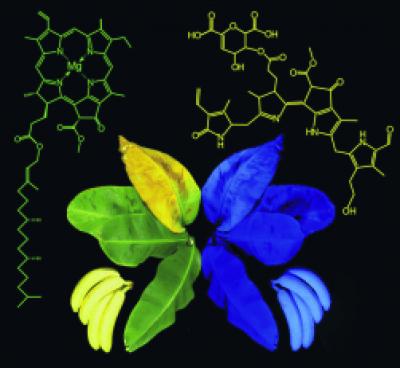- Adventures in Food No. 1: Camel milk chocolate.
- Adventures in Food No. 2: Hawaiian Chili Water.
- Adventures in Food No. 3: Beef.
- Adventures in Food No. 4: Fruits from abandoned orchards.
Nibbles: Funding, Cow Gods, Ãœber Bee, Rice, Bushmeat, Oaks
- $50 million for climate change. Must be some for agricultural biodiversity. Via, which has the application forms.
- How the Egyptians came to venerate cattle.
- Building a better bee.
- Official US rice harvest forecasts 20% too high. Chinese comment: “Without rice, even the cleverest housewife cannot cook.”
- How about without bushmeat?
- IUCN lists endangered oaks. Know any ex situ collections? Tell IUCN!
Blue bananas
Ripe bananas are of course yellow. However, under black light, the yellow bananas are bright blue, as discovered by scientists at the University of Innsbruck (Austria) and Columbia University (New York, USA). The team, headed by Bernhard Kräutler, reports in the journal Angewandte Chemie that the blue glow is connected to the degradation of chlorophyll that occurs during ripening. In this process, colorless but fluorescing breakdown products of chlorophyll are concentrated in the banana peel.
I kid you not.
Nibbles: Poland, Aguaje, Climate Change, Seed Law, Apples, Seed Secretariat
- Growing a new agriculture in Poland.
- After açai? Aguaje!
- Hector Mongi is heading to a CTA seminar on Implications of Climate Change for Sustainable Agriculture. Hope he blogs it.
- “Anti-farmer” seed law in Pakistan.
- “Look,” he says. “This was an orchard.”
- Wonderful photos of autumn; agricultural biodiversity prominent.
- Afghanistan’s National Seed Secretariat opens, re-opens hornets’ nest?
Nibbles: Link, Mango, Chickens, Apples, Urban, Aquaculture, More chickens
- Our latest link. Mas du Diable in France.
- The history of mango in Florida discussed.
- Historic poultry publication.
- Did I hear somebody say English apples are not very interesting? Via.
- A wheat crop grows in Manhattan.
- Hands-on aquaculture.
- Animal farm.
